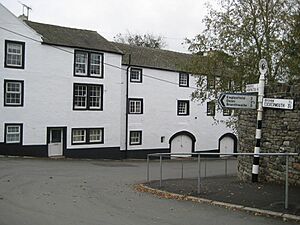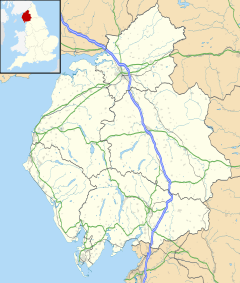Greysouthen facts for kids
Quick facts for kids Greysouthen |
|
|---|---|
 The Old Punchbowl Pub in Greysouthen |
|
| Population | 631 (2011) |
| OS grid reference | NY07086 29077 |
| • London | 250 mi (400 km) S |
| Civil parish |
|
| District | |
| Shire county | |
| Region | |
| Country | England |
| Sovereign state | United Kingdom |
| Post town | Cockermouth |
| Postcode district | CA13 |
| Dialling code | 019000 |
| Police | Cumbria |
| Fire | Cumbria |
| Ambulance | North West |
| EU Parliament | North West England |
| UK Parliament |
|
Greysouthen (/ˈɡreɪsuːn/ GRAY-soon) is a small village in Cumbria, North West England. It is located between the towns of Workington and Cockermouth. This historic village is also very close to the beautiful Lake District National Park. Greysouthen has a long and interesting connection with coal mining.
Contents
Greysouthen's Past: A Look at History
John Marius Wilson's 1870 Imperial Gazetteer described Greysouthen. It said the village had 136 houses. There was also a factory that made tools for farming. The village had chapels for Quakers and Wesleyans. There was even a mill that processed flax. In 1901, the area of Greysouthen civil parish was about 1,558 acres.
How Greysouthen is Governed
Greysouthen is part of the Workington area. This area elects a person to the UK Parliament. This person is called a Member of Parliament (MP). The current MP for Workington is Sue Hayman. She is a member of the Labour Party. The Labour Party has won this seat in every general election since 1979.
Before Brexit, people in Greysouthen voted for MEPs. These MEPs represented the North West England area in the European Parliament.
For local government, Greysouthen is in the Dalton Ward. This ward is part of Allerdale Borough Council. It is also in the Cockermouth South Division of Cumbria County Council. Greysouthen also has its own local council. This is called the Greysouthen Parish Council.
Greysouthen's Coal Mining History
People started digging for coal in west Cumbria a very long time ago. Evidence shows this activity began as early as the 13th century. In the Greysouthen area, coal mining began in the late 16th century.
In 1787, a large part of Greysouthen's coal rights was sold. It went to a company called William Walker & Company. This business made good money for the next 80 years. In 1800, another company, Wilson & Company, also started mining in Greysouthen. They opened another Colliery (a coal mine).
The two mining companies even used special coal tokens. These tokens showed how well the mines were doing. However, a big argument started between the two companies. They fought over who owned certain mining areas. Wilson & Co had to pay £16,000 because they mined on William Walker & Company's land without permission.
By the early 1800s, coal mining was very important in Greysouthen. It was the main job for most people. To house the miners, small rows of cottages were built in the village. In 1823, Joseph Birbeck and J.W. Flecter also started mining in Greysouthen. They paid a tax of £20 each year to mine 400 tons of coal. If they mined more than that, they paid an extra 1 shilling for each extra ton.
The Melgramfitz pit was a coal mine that closed in 1886. This closure marked the end of Greysouthen as a coal mining community. Miners from Greysouthen in the 19th century were known for enjoying their ale. Local officials often thought this was their main interest.
Life in the Greysouthen Community
Greysouthen is surrounded by green farmland. Two small streams flow through this area. The people who live in the village often divide it into two parts. They call them "up the went" and "down the went." The 'went' is a hill right in the middle of Greysouthen.
St Joseph's Roman Catholic Church is about 3 kilometres (1.9 miles) from the village centre. Greysouthen has a large playing field. It has an adventure playground and a football pitch. There is also a garden that celebrates the Queen's Silver Jubilee.
Greysouthen used to have a bus service. Buses ran about ten times a day. They connected the village to Workington and Cockermouth. This bus service was supported by the local council. It was run by smaller bus companies. However, the service stopped in 2015.
The village is in the area for Paddle Primary Academy. This is a Church of England school in the nearby village of Eaglesfield. Greysouthen is also in the catchment area for Cockermouth School and Keswick School. Cockermouth School is closer to the village.
The parish council has been working to help local rural communities. They have supported getting superfast broadband and mobile coverage. Superfast broadband was finally turned on in the village in January 2015.
Greysouthen's Wildlife and Plants
There are 7 beaches within 10 miles (16 kilometres) of Greysouthen. Siddick beach is the closest, about 5 miles (8 kilometres) away. After that, the closest beaches are Maryport, then Workington, Crosscanonby, Allonby, Parton, and Whitehaven.
The Greysouthen area is home to many different kinds of birds. You might see northern lapwings, common snipes, and Eurasian curlews. Other birds include common woodpigeons, buzzards, and Eurasian oystercatchers. You can also spot common pheasants, Eurasian sparrowhawks, and quail. Red squirrels also live in this area.
Many beautiful butterflies fly around Greysouthen. These include orange tips, red admirals, and painted lady butterflies.
Some special wild plants grow in west Cumbria near Greysouthen. These include the greater butterfly orchid, the early purple orchid, and yellow rattle.
Greysouthen's Changing Population
| Population growth in Greysouthen since 1880 | |||||||||||||||||||||||||||||||||||||||
|---|---|---|---|---|---|---|---|---|---|---|---|---|---|---|---|---|---|---|---|---|---|---|---|---|---|---|---|---|---|---|---|---|---|---|---|---|---|---|---|
|
|
|
|
||||||||||||||||||||||||||||||||||||
The number of people living in Greysouthen changed a lot between 1880 and 1900. The population went down by about 210 people in 20 years. This happened after the local coal mines closed down.


